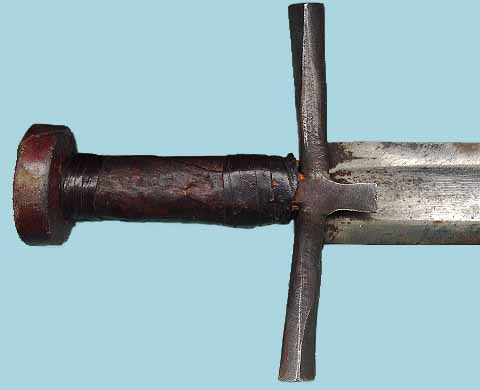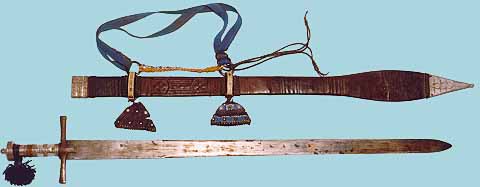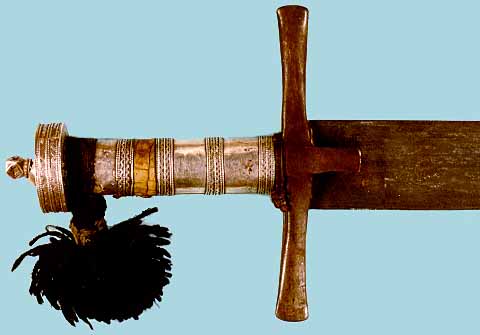 |
 |
|
|
 |
 |
|
|
The kaskara is characteristic of the western parts of that broad African savanna region known as the Sudan, areas now part of Chad and Sudan (the country). While most surviving examples are from the 19th Century, the type is believed to have originated in the 16th Century, and may represent a localized survival of the straight, double edged medieval Arab sword (North, 1989, p. 142). Victorian era writers on swords frequently opine that these are survivals of European medieval swords, but this view in presently strongly disfavored. A later European influence is present, however, in that the blades, even from the 16th Century, are frequently of European manufacture or of local manufacture clearly imitating European blades and their markings (Briggs, 1965, p.44 and Spring, 1993, p. 41-42). Spring notes that the kaskara has continued to be worn in rural areas of Darfur at least until very recently, if not presently, and the well worn condition of example 2, illustrated below, supports this contention. The kaskara is worn horizontally across the back or between the upper arm and thorax (Spring, 1993, p. 41).
The blades are usually about a yard long (or just under a meter), double edged and with a spatulate tip. The edges are typically parallel for most of the length of the blade, although a slight taper may also be seen. Example 1, above, has a broad central fuller running from the crossguard nearly to the tip of the sword. Many better grade blades will have a single, moderately wide, short fuller running about a quarter to a third of the blade length. Other varieties, typical of European broad double-edged trade blades of the times, have been observed, such as those with three (or so) narrow, short to moderately long fullers (as are also seen in takoubas and espada anchas; similar astrological engravings may also be seen, further suggesting similar, if not the same, sources of imported blades.) The frequent presence of European bladesmith's marks on these blades are not a reliable indicator of blade origin, as such marks were frequently copied in imitation of those on imported blades by local smiths (Spring, 1993, p. 42). Koranic and talismanic inscriptions are also found inscribed on kaskara blades, regardless of origin.
While fine old heirloom blades may be found in kaskaras, both in very old and in more modern mounts, current academic opinion it that is highly unlikely that any of the blades date before the 15th Century. (Opinion - While one supposes that it is always possible that a shipment of European blades destined for Africa could have contained salvaged medieval blades, such a razor-thin possibility cannot possibly justify the vandalism upon the thousands of kaskaras which have been re-hilted in European medieval style by those rare individuals misguided and ignorant enough to feel that they are undertaking a restoration and by the many perpetrating fraud! Collector's note - While Ewart Oakeshott (1991, p.38) is quite correct to criticize the auction house expert who incorrectly attributed a particular 11th Century European medieval sword as being a composite fake with a Sudanese blade - happy ending, he bought the sword cheaply - the vast, vast majority of European medieval style swords on the market today with any features of a kaskara are probably mutilated kaskaras - unhappy ending if you are the buyer. Beware. Beware!)
Kaskara hilts resemble, only coincidentally, medieval European swords in having a simple crossguard. The crossguard has a typical short extension toward the blade centrally, a languet, which Briggs (1965, p. 45) surmises is likely of Turkish stylistic origin. The crossguard is usually forged of iron; brass examples are also known (Briggs, 1965, p.45). The pommel is of disk form, likely composed of wood, mounted with the flat faces perpendicular to the center line of the sword blade. The grip tends to be round. Both grip and pommel are covered with leather in poorer examples and with embossed and or overlain silver (and even gold) in finer examples.
The scabbards are characteristically of red-brown or brown leather; sometimes exotic hides will be used. A leaf-shaped flaring in the width of the scabbard is characteristic just before the tip. Better examples will have chapes and other fittings of precious metal.
 |
 |
|
|
Briggs, Lloyd Cabot, "European Blades in Tuareg Swords and Daggers," The Journal of the Arms & Armour Society [U.K.] Vol. V. No. 2. (1965), p. 37 - 92.
North, Anthony, "Swords of Islam," in Swords and Hilt Weapons (New York: Weidenfeld & Nicolson, 1989) p. 136 - 147.
Spring, Christopher, African Arms and Armour, (London: British Museum Press, 1993).
Spring, Christopher, "African Hilt Weapons," in Swords and Hilt Weapons (New York: Weidenfeld & Nicolson, 1989) p. 204 - 217.